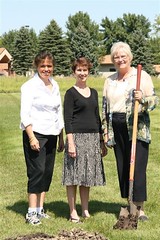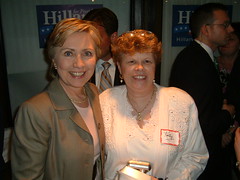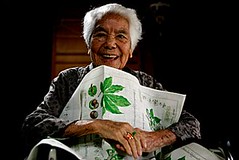Fitness and The Greatest Generation
 Congratulations to Ecumen team members at The Pines and The Oaks in Hutchinson. They were a recipient of an Ecumen Majestic Oak Award for Innovation, which they received for developing a new initative that improves the lives of the people we serve and is adapted at other Ecumen communities. For more on the Ecumen Innovation Station program, go here.(Pictured L to R: Peggy Sugheimer, Kathryn Roberts and Joyce Aakre after the planting of the Ecumen Majestic Oak in Hutchinson).While prevention and fitness are becoming more prevalent in the next generation of seniors, they’re not as prevalent in the Greatest Generation. The team at Hutchinson (and Shelly Sohre, who now leads another Ecumen community) have created a fitness initiative where residents at The Oaks and The Pines pick a destination and then measure their miles. They’ve walked to Sturgis, Chicago and Dallas. When they reach their destination, they have a huge themed-party. They also have had a philanthropic component tied to it where local businesses make donations based on the number of miles that our customers have walked. If you have other creative programs that engage today’s seniors in fitness, please share them.
Congratulations to Ecumen team members at The Pines and The Oaks in Hutchinson. They were a recipient of an Ecumen Majestic Oak Award for Innovation, which they received for developing a new initative that improves the lives of the people we serve and is adapted at other Ecumen communities. For more on the Ecumen Innovation Station program, go here.(Pictured L to R: Peggy Sugheimer, Kathryn Roberts and Joyce Aakre after the planting of the Ecumen Majestic Oak in Hutchinson).While prevention and fitness are becoming more prevalent in the next generation of seniors, they’re not as prevalent in the Greatest Generation. The team at Hutchinson (and Shelly Sohre, who now leads another Ecumen community) have created a fitness initiative where residents at The Oaks and The Pines pick a destination and then measure their miles. They’ve walked to Sturgis, Chicago and Dallas. When they reach their destination, they have a huge themed-party. They also have had a philanthropic component tied to it where local businesses make donations based on the number of miles that our customers have walked. If you have other creative programs that engage today’s seniors in fitness, please share them.
The Senior Federation and the Age Wave
Last week was a pretty interesting action packed week related to changing aging' in Minnesota … you can feel people feeling an opportunity to transform aging …- There was the Department of Human Services Transform 2010 Summit in St. Paul. It was packed with more than 200 people looking at the future. If you want to attend one of these sessions in your part of the state, here’s a link to upcoming meetings this month and next. - Archbishop Harry Flynn came out on Friday with his first of a three-part column series in the Archdiocesean newpaper on the Archdiocese of St. Paul/Minneapolis work in preparing for the Age Wave. You can read his recent Pastoral Letter on Aging here.- And then there was a fascinating discussion hosted by the Minnesota Senior Federation to discuss reframing the role and responsibilty of the Senior Federation as it enters the Age Wave. People of varied ages were there from diverse sectors, such as health plans, foundations, senior housing organizations, marketing, and elsewhere.What was especially interesting (and energizing) is how people of various ages all agreed on things that were on their mind as they think about Minnesota’s age wave. Here are a number of them in various categories:Economic- Not outliving income- Housing: staying or moving?- Legacy planning- Who will take care of Minnesotans?- Going from 'Working' to 'Lifework' (Remember, most boomers said in our Age Wave Study, they’re going to do work they enjoy)- Working on my terms, not someone else’s- Starting up businessesSocial/Community- Want to stay in community- Want social contact- Opportunities for civic and social engagement- Lifelong learningRecreation/Lifestyle- Say goodbye to the 'senior center'; will be replaced by community centers/all ages- Alternative housing options- 'Senior Needs' won’t be so much different from rest of the community; in other words seniors won’t be viewed as so different from the rest of the community- Need transportation to maintain lifestyle- Stay physically active- technology (social networking)Health and Wellness- Access to health services; doctor will see them- Be able to afford care- Proactive, preventive health care- Keeping seniors active- Enabling independence- Technology (sharing information, reach into rural areas)As Bob Dylan sang, 'The times, they are a changing.'
Are You Going to Stop Working?

Last night Kathy Adams, who leads Arlington Place of Oelwein, Iowa, an Ecumen-managed community, was elected to the school board in Oelwein. (Word is that Hillary wanted to meet a person in the heartland who represents America’s changing face of retirement.) Kathy is planning on retiring soon, but let’s get real, anyone who has met her knows she’s not really going to retire, she’s going to keep using her skills in building community. That school board job is going to be a lot of work. Kathy won’t be alone. Many others are joining her in redefining retirement.Today Dave Phelps had an interesting front-page article in the Minneapolis Star Tribune: 'Retirement Age Doesn’t Mean 65.' According to his article, U.S. Census data shows: - 23.2% of U.S. residents 65 to 74 are working. - In Minnesota, that percentage is higher, 26.3 percent. -Of Twin Cities residents in their late 60s and early 70s, more than one in four, or 27.4% are working. -Among the top 20 largest metros in the U.S., only Washington D.C., Boston, and Dallas-Fort Worth are higher.A lot of boomers don’t plan on retiring. We learned that in our Age Wave Study. Many of them also say they’re going to change jobs and do work that they enjoy. This is going to change the face of the workplace significantly, including different benefit structures, flexible scheduling, more entrepreneurial efforts and a whole host of other areas.How do you view retirement? Are you going to have a traditional retirement and stop working, or will you continue working/do some work?
What’s Up With This?
Not sure why nearly a 1/2 page in the morning newspaper was devoted to Britney Spears today , but check out this first paragraph from the Associated Press, especially the second sentence.As in most train wrecks, it was hard to focus on just one thing as the Britney Spears disaster unfolded on MTV’s Video Music Awards. There was just so much that went wrong … . Lethargic movements that seemed choreographed by a dance instructor for a nursing home… . At times, she just stopped singing, as if even she knew nothing could save her performance. It’s like the congressional ad last year in Minnesota that featured a young person dressed up in a grey wig, sitting on a parking bench, acting all meek and confused - generalizing that old people' are ah, meek and confused. Or the high-speed internet ad that’s running nationally that shows the 'before' and 'after' with high-speed internet service. The 'before' is a photo of a senior woman, the 'after' is a young beauty queen. You get the message …Ageist advertising and media depictions that fuel stereotypes need to go, go, go away. Aging is about living, even at the end of life. If you see ageism at work in the media, please submit it here. We can share it and hopefully help get it extinguished.
A Question for you …
Let’s pretend for a second that you have two things:1. Nothing holding you back from your visions (no rules, all the money in the world, no one to say no, absolutely nothing but wide open opportunity).2. A magic wand.What change or changes would you make to long-term care or aging services?Please answer by clicking below on comment' (you get to be an inventor and adventurer here, be whoever you want to be, yourself, Thomas Edison, Amelia Erhart, Richard Branson, anyone … this is pretend time).
A Question For You?
Do You Use the F Word?
FACILITY. I’ve used it a lot, but today I’m eliminating it from my vocabulary. Who wants to live in a facility? Guess what, honey, I’m moving to the FACILITY.' Yippeeee.Language triggers visions in the mind. Would you rather go to the ballpark or the stadium? Ballpark connotes smaller, open air, blue skies, maybe ivy on the walls. When I hear stadium I think of a concrete mass in the middle of a sea of parking lots. There’s a reason Major League Baseball doesn’t use the word 'stadium' anymore or why the American Association of Intellectual and Developmental Disabilities changed its name from the American Association on Mental Retardation, or some people use the phrase 'rightsize' instead of 'downsize' …In our Age Wave study, we asked baby boomers about several words in our profession. They can’t stand facility. And they don’t like campus. They really don’t like 'nursing home.' The word they embraced? Community. Makes total sense. Community vs. facility. One is much warmer, more inclusive, more vibrant, and people have lived in communities all of their life. Here’s an interesting perspective on language from Elite Care, a senior housing company in Oregon:We adopt a new vocabulary to erase debilitating stereotypes. Think about typically used elder care terms such as 'assisted,' 'caregiver,' 'administrator,' 'aide,' 'nurse,' and 'facility.' These words imply sickness, disability, and mindsets that inhibit creation of healthy power structures. Then consider words like 'facilitate,' 'elder,' 'extended family,' 'Life Enhancing Tasks,'„¢ and Neighborhood Coordinator. This new vocabulary does not make elders 'objects of care,' or make staff overprotect residents, because of stereotypes bolstered by language.Here’s another look at language from Paul Kleyman, editor of Aging Today, and a survey he directed at the American Society on Aging:In the June 2007 ASA Connection, readers answering our “Quick Question” about terms for people ages 65-plus overwhelmingly favored older adults, with elders running second. Now, thanks to a new study from the Journalists Exchange on Aging, we have a chance to see how reporters and editors view the issue -- and it turns out that both terms also made the journalists’ preferred list. By contrast, senior citizen found little favor in either camp: The JEOA study dismisses the label as “euphemistically sour,” and only 10.8 percent of the “Quick Question” respondents found it acceptable. Interestingly, in the survey we did of Minnesota baby boomers, 'senior' was preferred by 48% of respondents, 40% preferred 'older adult' and only 9% liked 'elder' the best. What is abundantly clear, however, is that there is a huge opportunity to change the language of aging services. What are words that you’d like to see changed?
50, 60, 70, 80, 90, 100, 110, … Models Wanted
AARP The Magazine is looking for the Faces of 50+€”real men and women (no professionals, please!) who look and feel great at 50 and beyond. Selected models may appear in fashion and beauty articles in AARP The Magazine throughout 2008. It’s free and easy to nominate someone or yourself online. The deadline is October 15th.
50, 60, 70, 80, 90, 100, 110... Models Wanted
AARP The Magazine is looking for the Faces of 50+€”real men and women (no professionals, please!) who look and feel great at 50 and beyond. Selected models may appear in fashion and beauty articles in AARP The Magazine throughout 2008. It’s free and easy to nominate someone or yourself online. The deadline is October 15th.
Secrets in Successful Aging From Around the Globe

National Geographic Magazine about two years ago traveled the world and looked at several communities and their secrets for longevity. You can watch a video clip from their travels here. Here are a few interesting things they learned about successful aging:From Sardinia in Italy, where men reach 100 at a rate more than twice as high as the average for Italy, they took these tips:- Drink red wine (in moderation)- Share the work burden with spouse- Eat pecorino cheese (and other omega-3 foods)From Seventh-day Adventists in California who live four to 10 years longer than the state’s average, they took away these tips for longevity:- Eat nuts and beans- Observe the Sabbath- Have faithIn Japan, Okinawans' average life expectancy of 82 years is among the longest in the world. Tips from Japan:- Keep lifelong friends- Eat small portions- Find purposeThings they learned that were common to all three communities were:- Don’t smoke- Put family first- Be active every day- Keep socially engaged- Eat fruits, vegetables and whole grainsAging … it is all about living. Have a great Labor Day Weekend. See you next week.

